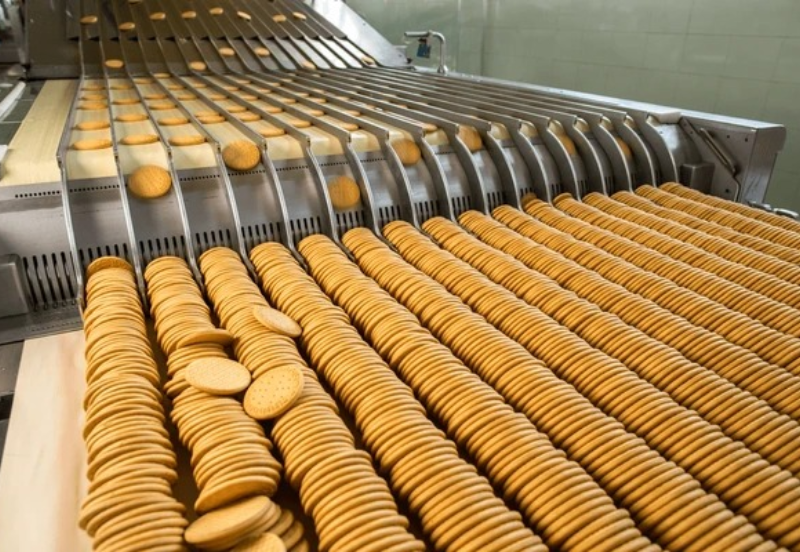-
Send us a mail [email protected]
-
Call us anytime +91-9999884400

Biscuit Making Machine are a staple snack enjoyed by people of all ages. They are available in various shapes, sizes, and flavors, catering to a wide range of preferences. Have you ever wondered what goes into the production of these delicious treats? Biscuit manufacturing is a fascinating process that requires precision, quality control, and efficient handling of raw materials. Let’s take a closer look at how biscuits are made and how the raw materials are managed to ensure top-notch quality.
Understanding the Biscuit Manufacturing Process
The biscuit making machine process involves several steps, each contributing to the texture, taste, and appearance of the final product. From selecting raw materials to packaging the finished biscuits, every step is crucial. Here’s a breakdown of the key stages:
Raw Material Preparation
Raw materials are the foundation of biscuit making machine. Common ingredients include:
To ensure consistency and quality, raw materials undergo stringent quality checks before entering the production line. Contaminated or low-quality materials can affect the taste, texture, and shelf life of the biscuits.
Mixing and Dough Formation
Once the raw materials are prepared, they are blended in precise proportions. Mixing is a critical step where flour, sugar, fats, and other ingredients are combined to form a homogenous dough. Advanced mixers are used to achieve consistent texture and ensure the dough is free of lumps.
The dough’s consistency plays a significant role in the final biscuit making machine. If the dough is too hard or too soft, it can lead to uneven baking or unwanted texture.
Shaping and Cutting
After mixing, the dough is rolled out and shaped into the desired forms. This step determines the biscuit's appearance, which can range from simple circles to intricate patterns.
Modern biscuit manufacturing plants use automated cutting and shaping machines that deliver uniformity and precision at high speeds. These machines can produce thousands of biscuits per hour, making them essential for large-scale production.
Baking
Baking is where the magic happens. The shaped dough pieces are transferred to ovens, where they are baked at controlled temperatures.
Proper temperature control is crucial during this stage. If the biscuits are overbaked, they become too hard; underbaking leaves them soft and unappealing.
Cooling and Packaging
Once baked, the biscuits are cooled to room temperature before packaging. Cooling prevents moisture build-up inside the packaging, which can lead to sogginess or spoilage.
Packaging is equally important. Automated systems are often used to ensure hygienic and airtight packing. Proper packaging not only preserves freshness but also extends the shelf life of the biscuits.
Raw Material Handling System
Efficient handling of raw materials is vital for smooth biscuit production. A well-designed raw material handling system minimizes waste, reduces production downtime, and ensures consistency.
Storage of Raw Materials
Raw materials like flour and sugar must be stored in clean, dry, and temperature-controlled environments. Proper storage prevents spoilage and contamination, ensuring that the ingredients remain fresh.
Conveying Systems
Modern manufacturing units use advanced conveying systems to transport raw materials from storage to production lines.
These systems save time and labor, making the production process more efficient.
Quality Checks During Handling
Quality control is a continuous process in biscuit making machine. During raw material handling, regular checks are performed to:
By implementing rigorous quality checks, manufacturers can produce biscuits that meet consumer expectations.
Challenges in Raw Material Handling
Despite advancements in technology, raw material handling poses some challenges:
To address these challenges, manufacturers invest in high-quality equipment and robust storage facilities.
Innovations in Biscuit Manufacturing
The biscuit industry continues to evolve with new technologies and sustainable practices. Here are some innovations transforming the sector:
These innovations not only enhance production efficiency but also cater to the growing demand for sustainable practices.
Conclusion
Biscuit manufacturing is a complex process that requires attention to detail at every step. From the careful selection of raw materials to the final packaging, each stage is designed to deliver biscuits that are delicious, consistent, and safe to consume. Efficient raw material handling systems play a crucial role in maintaining quality and reducing waste, ensuring that manufacturers can meet the expectations of their customers.
FAQs
1. What are the main ingredients used in biscuit manufacturing?
Flour, sugar, fats, leavening agents, and flavorings are the primary ingredients.
2. Why is temperature control important during baking?
Temperature control ensures that biscuits are baked evenly, achieving the desired texture and taste.
3. How do modern conveying systems improve raw material handling?
Conveying systems reduce manual labor, minimize waste, and ensure efficient transportation of raw materials.
4. What measures are taken to prevent contamination in raw materials?
Proper storage, hygiene protocols, and regular quality checks help prevent contamination.
5. What are the benefits of using automated packaging systems?
Automated systems ensure hygienic, airtight packing and improve the shelf life of biscuits.
